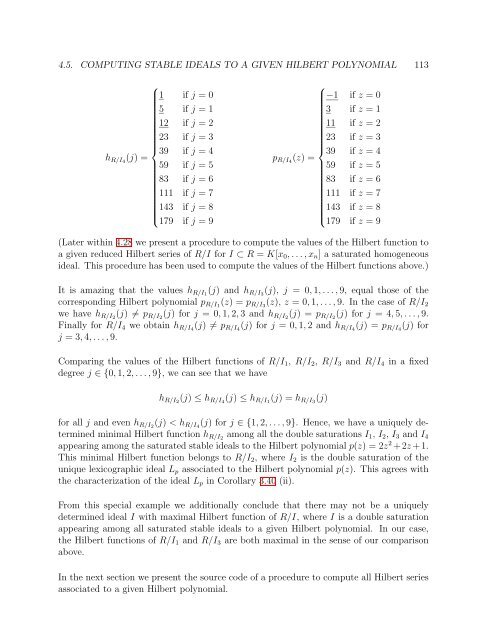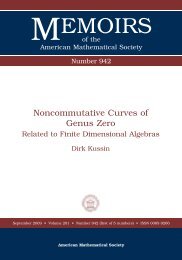University of Paderborn Department of Mathematics Diploma Thesis ...
University of Paderborn Department of Mathematics Diploma Thesis ...
University of Paderborn Department of Mathematics Diploma Thesis ...
You also want an ePaper? Increase the reach of your titles
YUMPU automatically turns print PDFs into web optimized ePapers that Google loves.
4.5. COMPUTING STABLE IDEALS TO A GIVEN HILBERT POLYNOMIAL 113⎧1 if j = 05 if j = 112 if j = 223 if j = 3⎪⎨39 if j = 4h R/I4 (j) =59 if j = 583 if j = 6111 if j = 7143 if j = 8⎪⎩179 if j = 9⎧−1 if z = 03 if z = 111 if z = 223 if z = 3⎪⎨39 if z = 4p R/I4 (z) =59 if z = 583 if z = 6111 if z = 7143 if z = 8⎪⎩179 if z = 9(Later within 4.28 we present a procedure to compute the values <strong>of</strong> the Hilbert function toa given reduced Hilbert series <strong>of</strong> R/I for I ⊂ R = K[x 0 , . . . , x n ] a saturated homogeneousideal. This procedure has been used to compute the values <strong>of</strong> the Hilbert functions above.)It is amazing that the values h R/I1 (j) and h R/I3 (j), j = 0, 1, . . . , 9, equal those <strong>of</strong> thecorresponding Hilbert polynomial p R/I1 (z) = p R/I3 (z), z = 0, 1, . . . , 9. In the case <strong>of</strong> R/I 2we have h R/I2 (j) ≠ p R/I2 (j) for j = 0, 1, 2, 3 and h R/I2 (j) = p R/I2 (j) for j = 4, 5, . . . , 9.Finally for R/I 4 we obtain h R/I4 (j) ≠ p R/I4 (j) for j = 0, 1, 2 and h R/I4 (j) = p R/I4 (j) forj = 3, 4, . . . , 9.Comparing the values <strong>of</strong> the Hilbert functions <strong>of</strong> R/I 1 , R/I 2 , R/I 3 and R/I 4 in a fixeddegree j ∈ {0, 1, 2, . . . , 9}, we can see that we haveh R/I2 (j) ≤ h R/I4 (j) ≤ h R/I1 (j) = h R/I3 (j)for all j and even h R/I2 (j) < h R/I4 (j) for j ∈ {1, 2, . . . , 9}. Hence, we have a uniquely determinedminimal Hilbert function h R/I2 among all the double saturations I 1 , I 2 , I 3 and I 4appearing among the saturated stable ideals to the Hilbert polynomial p(z) = 2z 2 + 2z + 1.This minimal Hilbert function belongs to R/I 2 , where I 2 is the double saturation <strong>of</strong> theunique lexicographic ideal L p associated to the Hilbert polynomial p(z). This agrees withthe characterization <strong>of</strong> the ideal L p in Corollary 3.40 (ii).From this special example we additionally conclude that there may not be a uniquelydetermined ideal I with maximal Hilbert function <strong>of</strong> R/I, where I is a double saturationappearing among all saturated stable ideals to a given Hilbert polynomial. In our case,the Hilbert functions <strong>of</strong> R/I 1 and R/I 3 are both maximal in the sense <strong>of</strong> our comparisonabove.In the next section we present the source code <strong>of</strong> a procedure to compute all Hilbert seriesassociated to a given Hilbert polynomial.
















